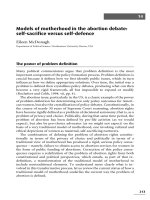Communication Models Presentation
Bạn đang xem bản rút gọn của tài liệu. Xem và tải ngay bản đầy đủ của tài liệu tại đây (263 KB, 39 trang )
Communication Models
Unit 2: Listening & Comm.
English 9
Mr. Hill
Introduction
• Communication, like most anything else,
can be studied in order to find out
exactly how it works.
• This can be done in real life situations or
it can be done on a more “academic”
level.
• This presentation will show you the three
most recognized and accepted models of
communication and how they work.
MODEL #1: CONTINUOUS
LOOP MODEL
• This is the EARLIEST model of
communication that has been
presented and accepted by others who
study the field.
• It is also the SIMPLEST model (though
it might not look like it at first).
• It includes all of the basic parts/players
in the communication process.
• There are still a few problems, though!
Continuous
Loop Model
CONTENT
Continuous
Loop Model
M
MESSAGE
CONTENT
Continuous
Loop Model
Channels
M
MESSAGE
CONTENT
Continuous
Loop Model
Channels
M
MESSAGE
S
SENDER
CONTENT
Continuous
Loop Model
Channels
M
MESSAGE
S
SENDER
CONTENT
Info
Source
Continuous
Loop Model
Channels
M
MESSAGE
S
SENDER
CONTENT
RECEIVER
R
Info
Source
Continuous
Loop Model
Break = diff. Message
received = confusion
Channels
M
MESSAGE
S
SENDER
CONTENT
RECEIVER
R
Info
Source
Continuous
Loop Model
Break = diff. Message
received = confusion
Channels
M
MESSAGE
S
Info
Source
SENDER
CONTENT
RECEIVER
R
FEEDBACK
F
Continuous
Loop Model
Break = diff. Message
received = confusion
Channels
M
MESSAGE
S
Info
Source
SENDER
CONTENT
RECEIVER
R
FEEDBACK
Break = diff info sent to
Sender = improper reactions
F
Continuous
Loop Model
CONTINUOUS LOOP
• This model is based upon the
concept that language is a
system or a machine.
• In this machine, communication
acts as the “gears” for the
machine to work properly.
• Any breakdowns hurt efficiency!
CONTINUOUS LOOP
• While this is the EARLIEST model
of communication, it is not
known who the developer or the
creator of the model was.
• The only thing we know for sure
is that it was most-likely
developed in the 1920s or
1930s.
CONTINUOUS LOOP
• One of the flaws of the model is
that it assumes “continuous”
communication.
• There are times when we choose
to stop communicating.
• In other words, this is good on
paper, but it does not fit all
situations.
MODEL #2: SHANNON &
WEAVER
• This model was created in 1949.
• It is not certain if this pair of
researchers had seen the
“Continuous Loop” model, but
they were probably at least
familiar with it.
• This model was designed to be
practical!
MODEL #2: SHANNON &
WEAVER
• Just as the “Loop” model was
more “academic,” the Shannon &
Weaver Model is more “down-toearth.”
• The basis for this model was a
study of telephone conversations
over a very lengthy 2-year time.
MODEL #2: SHANNON &
WEAVER
• The team studied only what they
deemed to be “important” or
“significant” calls of some length.
• Quick calls to a neighbor or a
store were not considered for the
study.
• The focus was on the
“mechanics” of the messages.
Shannon and Weaver Model
Transmitter = Phone
T
Shannon and Weaver Model
Transmitter =
Phone
T
Receiver = Phone
R
Shannon and Weaver Model
Transmitter =
Phone
S
T
Sender =
Info Source
Receiver = Phone
R
Shannon and Weaver Model
Transmitter =
Phone
S
T
Sender = Info
Source
Receiver = Phone
R
R
Shannon and Weaver Model
Transmitter =
Phone
S
T
Sender = Info
Source
Receiver = Phone
N
R
R
NOISE
Shannon and Weaver Model
Transmitter =
Phone
S
T
Sender = Info
Source
Receiver = Phone
N
R
R
NOISE
Static or Connection









